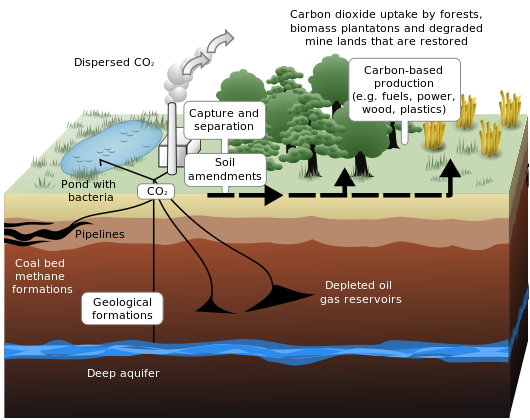As explained in a previous post, Government policy can have enormous impact in shaping our technological base in the future by promoting the “locking in” or “locking out” of certain technological innovation.
Just as Governments can help incentivize the “lock in” of renewable energy technology into our energy future, their decisions can also play a large role in whether or not we can “kick the habit” for fossil fuels.
One example if this comes in the European Union’s support of Carbon Capture and Storage technology through the NER300 Programme.
Carbon Capture and Storage (CCS)
Carbon Capture and Storage is a technology meant to capture the CO2 emissions from coal, oil, or gas plants combustion and store it so that it is not emitted into the atmosphere, which would further aggravate climate change.
Sounds interesting right?
Some of the details still need to be resolved. For example, scientists are still working out where and how to store the CO2 once it has been captured. As of now, most scientific innovation is leading towards geological sequestration in saline aquifers in which the C02 is injected into these geological sites deemed safe for carbon sequestration. (For a more detailed explanation of CCS technology, visit this interactive website)
CCS and “Lock Out”
One of the main concerns regarding CCS is that it will likely promote the continued construction of fossil fuel plants in the future. Given that carbon plants have a lifespan of about 40 years, every new coal plant built this year will still be working, and polluting, in 2053.
If CCS technology becomes efficient and lucrative in the short term, it will quickly expand, therefore “locking us in” to carbon intensive energy production in the future. (With the additional process of storing that emitted carbon underground). Even worse, if CCS technology becomes widely adopted, some renewable energy technologies may be “locked out” of our technology base. Its implementation will likely cut funding towards renewable energy R&D projects – which may have been the future solutions to meet our energy demands.
CCS technology does not help the European Union reach its targets of becoming a truly low carbon economy in the future. It does not reduce CO2 production, but simply stores the CO2 being emitted. Carbon Capture and Storage may hinder us from fully reaching our low carbon economy potential.
So, why the interest in CCS?
Despite the fact that CCS technology is a “second best” option to curb CO2 emissions from being emitted into the atmosphere, there is a case to be made for its use – given our current political and energy situation. A prime example of the lack of political will in the international arena was seen last December at the Doha Climate conference.
The World Resources Institute identified that 1,200 new coal plants were in the planning stages in 59 countries last November – about three-quarters of those plants in China and India. These countries are “locking themselves in” to another 40 years of carbon intensive energy production. Without the interest and support of countries like the US, China and India, CCS may be the only way to avoid severe climate change.
Therefore, many argue that CCS technology would “buy us time” to allow political will to catch up and avoid a significant increase in climate change.
The global aspect of this issue makes the debate around CCS technology complicated:
May it keep us “hooked on” fossil fuels significantly longer that we should be? – Yes.
But, might it be the only chance we have to keep the planet from warming more than the goal of 2 degrees Celsius? – From the looks of it, most likely.
In my opinion, CCS technology is a necessary evil. It is not a perfect solution, and will come with its own set of issues (possible leakages, geological disruptions, etc). However, with 1,200 new coal plants on their way, it may be the only option we have to avoid further climate change.
Given the current situation, James Smith, contributor for the Guardian, may be correct when he states:
We all must get real and get behind the [CCS] technology. Government and industry must work together urgently to build the essential demonstration projects over the next few years. The carbon market, post-2020, must be underpinned now with very strong signals for a carbon price that will stimulate all kinds of low-carbon investment, including CCS. And the government must continue with R&D to reduce costs and risks.
At least, in his promotion of CCS technology he also states the importance of strong carbon prices and “all kinds of” low carbon investments to compliment the continued use of fossil fuels…
Image Credit: First Image from FreeFoto, Creative Commons Licensed. Second Image from LeJean Hardin and Jamie Payne Creative Commons Licensed.
